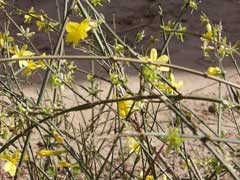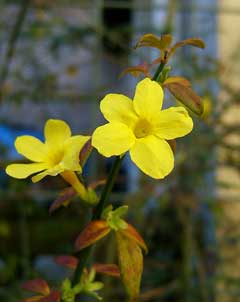 |
|
http://commons.wikimedia.org/wiki/User:Fanghong |
 |
| http://commons.wikimedia.org/wiki/User:Wildfeuer |
Translate this page:
Summary
Bloom Color: Yellow. Main Bloom Time: Early winter, Late winter, Mid winter. Form: Rounded, Spreading or horizontal, Weeping.
Physical Characteristics

 Jasminum nudiflorum is a deciduous Shrub growing to 3.6 m (11ft) by 4.5 m (14ft) at a medium rate.
Jasminum nudiflorum is a deciduous Shrub growing to 3.6 m (11ft) by 4.5 m (14ft) at a medium rate.
See above for USDA hardiness. It is hardy to UK zone 6. It is in flower from December to March. The species is hermaphrodite (has both male and female organs) and is pollinated by Insects.
Suitable for: light (sandy), medium (loamy) and heavy (clay) soils, prefers well-drained soil and can grow in heavy clay soil. Suitable pH: mildly acid, neutral and basic (mildly alkaline) soils and can grow in very acid and very alkaline soils.
It can grow in full shade (deep woodland) semi-shade (light woodland) or no shade. It prefers moist soil. It can tolerate atmospheric pollution.
UK Hardiness Map
US Hardiness Map
Synonyms
J. sieboldianum.
Plant Habitats
Woodland Garden Dappled Shade; Shady Edge; not Deep Shade; Ground Cover;
Edible Uses
References More on Edible Uses
Medicinal Uses
Plants For A Future can not take any responsibility for any adverse effects from the use of plants. Always seek advice from a professional before using a plant medicinally.
Diaphoretic
Diaphoretic[178].
References More on Medicinal Uses
The Bookshop: Edible Plant Books
Our Latest books on Perennial Plants For Food Forests and Permaculture Gardens in paperback or digital formats.

Edible Tropical Plants
Food Forest Plants for Hotter Conditions: 250+ Plants For Tropical Food Forests & Permaculture Gardens.
More

Edible Temperate Plants
Plants for Your Food Forest: 500 Plants for Temperate Food Forests & Permaculture Gardens.
More

More Books
PFAF have eight books available in paperback and digital formats. Browse the shop for more information.
Shop Now
Other Uses
Soil stabilization
A good soil stabilizer for steep banks, succeeding in shady positions[200]. The sprawling branches make this a good plant for ground cover, the plants should be spaced about 1.8 metres apart each way[208].
Special Uses
Ground cover Scented Plants
References More on Other Uses
Cultivation details
Landscape Uses:Arbor, Cascades, Erosion control, Foundation, Ground cover, Massing, Screen, Standard. Succeeds in a good well-drained loam[1]. Grows well in heavy clay soils. Prefers a good soil and a sunny position but succeeds in shade[11, 28, 49], including on a north facing wall[200]. Tolerates very poor soils, whether acid or alkaline[202]. Tolerates urban pollution[200]. A very ornamental plant[1], it is hardy to about -15°c[184]. Some winter die-back can be experienced and flowers can be damaged in severe winters but new flowers are usually produced when the weather warms up[202]. A winter-flowering plant, flowering mainly on wood that was produced the previous summer[219]. Pruning can be carried out in early to mid spring once flowering has finished[202, 219]. Removing one third of the oldest growth down to ground level rejuvenates the plant and encourages greater flowering[202]. Unpruned plants tend to become woody and matted with dead stems[219]. The flowers have a delicate mossy perfume[245]. This species does not set seed in British gardens. This might be because all the plants in cultivation stem from one original importation[182]. An ideal plant for growing on shady walls and banks[28, 49]. Plants in this genus are notably resistant to honey fungus[200]. Special Features:
Not North American native, Attractive flowers or blooms.
References Carbon Farming Information and Carbon Sequestration Information
Temperature Converter
Type a value in the Celsius field to convert the value to Fahrenheit:
Fahrenheit:
The PFAF Bookshop
Plants For A Future have a number of books available in paperback and digital form. Book titles include Edible Plants, Edible Perennials, Edible Trees,Edible Shrubs, Woodland Gardening, and Temperate Food Forest Plants. Our new book is Food Forest Plants For Hotter Conditions (Tropical and Sub-Tropical).
Shop Now
Plant Propagation
Seed - best sown as soon as it is ripe in a cold frame. When they are large enough to handle, prick the seedlings out into individual pots and grow them on in the greenhouse for at least their first winter. Plant them out into their permanent positions in late spring or early summer, after the last expected frosts. Cuttings of half-ripe wood, July/August in a frame. Very easy. Cuttings of mature wood in November. Layering.
Other Names
If available other names are mentioned here
Native Range
TEMPERATE ASIA: China (Gansu Sheng, Shaanxi Sheng, Sichuan Sheng, Xizang Zizhiqu (southeast), Yunnan Sheng (northwest))
Weed Potential
Right plant wrong place. We are currently updating this section.
Please note that a plant may be invasive in one area but may not in your area so it's worth checking.
Conservation Status
IUCN Red List of Threatened Plants Status :

Growth: S = slow M = medium F = fast. Soil: L = light (sandy) M = medium H = heavy (clay). pH: A = acid N = neutral B = basic (alkaline). Shade: F = full shade S = semi-shade N = no shade. Moisture: D = dry M = Moist We = wet Wa = water.
Now available:
Food Forest Plants for Mediterranean Conditions
350+ Perennial Plants For Mediterranean and Drier Food Forests and Permaculture Gardens.
[Paperback and eBook]
This is the third in Plants For A Future's series of plant guides for food forests tailored to
specific climate zones. Following volumes on temperate and tropical ecosystems, this book focuses
on species suited to Mediterranean conditions—regions with hot, dry summers and cool, wet winters,
often facing the added challenge of climate change.
Read More
Expert comment
Author
Lindl.
Botanical References
11200266
Links / References
For a list of references used on this page please go here
Readers comment
© 2010, Plants For A Future. Plants For A Future is a charitable company limited by guarantee, registered in England and Wales. Charity No. 1057719, Company No. 3204567.